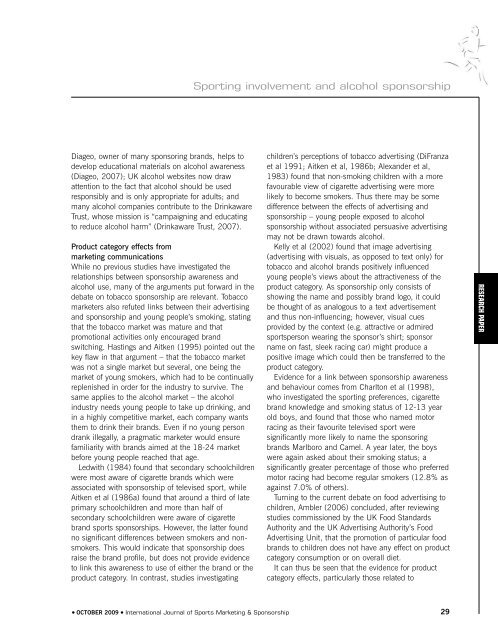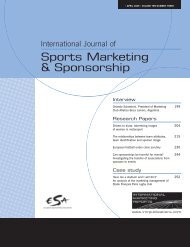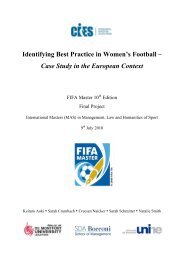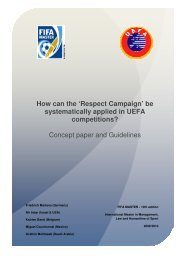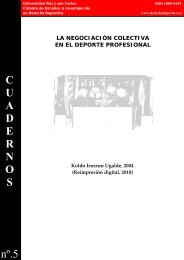Sports Marketing & Sponsorship - FIFA/CIES International University ...
Sports Marketing & Sponsorship - FIFA/CIES International University ...
Sports Marketing & Sponsorship - FIFA/CIES International University ...
- No tags were found...
Create successful ePaper yourself
Turn your PDF publications into a flip-book with our unique Google optimized e-Paper software.
Sporting involvement and alcohol sponsorshipDiageo, owner of many sponsoring brands, helps todevelop educational materials on alcohol awareness(Diageo, 2007); UK alcohol websites now drawattention to the fact that alcohol should be usedresponsibly and is only appropriate for adults; andmany alcohol companies contribute to the DrinkawareTrust, whose mission is “campaigning and educatingto reduce alcohol harm” (Drinkaware Trust, 2007).Product category effects frommarketing communicationsWhile no previous studies have investigated therelationships between sponsorship awareness andalcohol use, many of the arguments put forward in thedebate on tobacco sponsorship are relevant. Tobaccomarketers also refuted links between their advertisingand sponsorship and young people’s smoking, statingthat the tobacco market was mature and thatpromotional activities only encouraged brandswitching. Hastings and Aitken (1995) pointed out thekey flaw in that argument – that the tobacco marketwas not a single market but several, one being themarket of young smokers, which had to be continuallyreplenished in order for the industry to survive. Thesame applies to the alcohol market – the alcoholindustry needs young people to take up drinking, andin a highly competitive market, each company wantsthem to drink their brands. Even if no young persondrank illegally, a pragmatic marketer would ensurefamiliarity with brands aimed at the 18-24 marketbefore young people reached that age.Ledwith (1984) found that secondary schoolchildrenwere most aware of cigarette brands which wereassociated with sponsorship of televised sport, whileAitken et al (1986a) found that around a third of lateprimary schoolchildren and more than half ofsecondary schoolchildren were aware of cigarettebrand sports sponsorships. However, the latter foundno significant differences between smokers and nonsmokers.This would indicate that sponsorship doesraise the brand profile, but does not provide evidenceto link this awareness to use of either the brand or theproduct category. In contrast, studies investigatingchildren’s perceptions of tobacco advertising (DiFranzaet al 1991; Aitken et al, 1986b; Alexander et al,1983) found that non-smoking children with a morefavourable view of cigarette advertising were morelikely to become smokers. Thus there may be somedifference between the effects of advertising andsponsorship – young people exposed to alcoholsponsorship without associated persuasive advertisingmay not be drawn towards alcohol.Kelly et al (2002) found that image advertising(advertising with visuals, as opposed to text only) fortobacco and alcohol brands positively influencedyoung people’s views about the attractiveness of theproduct category. As sponsorship only consists ofshowing the name and possibly brand logo, it couldbe thought of as analogous to a text advertisementand thus non-influencing; however, visual cuesprovided by the context (e.g. attractive or admiredsportsperson wearing the sponsor’s shirt; sponsorname on fast, sleek racing car) might produce apositive image which could then be transferred to theproduct category.Evidence for a link between sponsorship awarenessand behaviour comes from Charlton et al (1998),who investigated the sporting preferences, cigarettebrand knowledge and smoking status of 12-13 yearold boys, and found that those who named motorracing as their favourite televised sport weresignificantly more likely to name the sponsoringbrands Marlboro and Camel. A year later, the boyswere again asked about their smoking status; asignificantly greater percentage of those who preferredmotor racing had become regular smokers (12.8% asagainst 7.0% of others).Turning to the current debate on food advertising tochildren, Ambler (2006) concluded, after reviewingstudies commissioned by the UK Food StandardsAuthority and the UK Advertising Authority’s FoodAdvertising Unit, that the promotion of particular foodbrands to children does not have any effect on productcategory consumption or on overall diet.It can thus be seen that the evidence for productcategory effects, particularly those related toRESEARCH PAPER● OCTOBER 2009 ● <strong>International</strong> Journal of <strong>Sports</strong> <strong>Marketing</strong> & <strong>Sponsorship</strong>29


